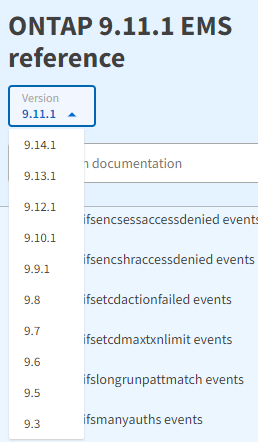What are the CIFS values to mitigate client malfunction?
Applies to
- ONTAP 9
- CIFS
Answer
The purpose of limits is the lower the chance of a client overwhelming a node in the cluster.
Examples:
| EMS message | EMS reference | Knowledge Base article |
|
|
nblade.cifsmaxsessperusrconn events (netapp.com) | CIFS shares access may fail and EMS displays error "cifsMaxSessPerUsrConn" |
Nblade.cifsSameTreePerSess |
nblade.cifssametreepersess events (netapp.com) | |
Nblade.cifsMaxOpenSameFile |
nblade.cifsmaxopensamefile events (netapp.com) | Error: Nblade.cifsMaxOpenSameFile when CIFS Clients attempt to access files in ONTAP |
Nblade.cifsMaxWatchesPerTree |
nblade.cifsmaxwatchespertree events (netapp.com) |
Note: Every cluster is different and may require different maximums due to physical constraints. Testing is required.
Additional Information
- Bugs Online - Syslog Translator (netapp.com)
- When consulting EMS reference, set Version field:

- The default values for these fields were increased in ONTAP 9.3.
- ONTAP systems upgraded to ONTAP 9.3+ may retain their original default values, though these values can still be modified as necessary
- Increasing a value is unlikely to cause any issue and should be considered when undesirable behaviour occurs as per above references
- This may be expected behaviour for services establishing a CIFS session on behalf of multiple users:
Examples:
- Xen server,
- IIS server or other web servers
Note: If not expected, client-side investigation with OS/Application vendor needs to be performed
- Recommendations should come from the Client OS/Application Vendor.
- Client OS/Application vendor provides no guidance on these values:
- If there is an expectation that the default value will be exceeded in a natural manner, but there is uncertainty about how the natural behavior will go, then testing higher values will be necessary.
- There is no perfect method of determining a perfect number to set the value to.
- One method of testing might be doubling the value, if the error returns, double again, etc.
- Another method is more slowly increasing the value until the error goes away. (assuming behavior of the OS/application vendor is expected)
